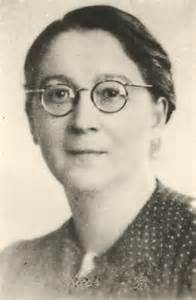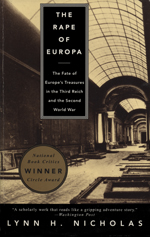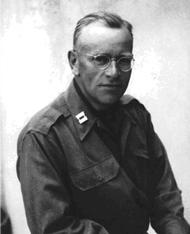
Art theft, sometimes called artnapping, is the stealing of paintings, sculptures, or other forms of visual art from galleries, museums or other public and private locations. Stolen art is often resold or used by criminals as collateral to secure loans. Only a small percentage of stolen art is recovered—an estimated 10%. Many nations operate police squads to investigate art theft and illegal trade in stolen art and antiquities.

Nazi plunder was organized stealing of art and other items which occurred as a result of the organized looting of European countries during the time of the Nazi Party in Germany.

Rose Antonia Maria Valland was a French art curator, member of the French Resistance, captain in the French military, and one of the most decorated women in French history. She secretly recorded details of the Nazi plundering of National French and private Jewish-owned art from France; and, working with the French Resistance, she saved thousands of works of art.

Rescuing Da Vinci is a largely photographic, historical book about art reclamation and preservation during and after World War II, written by American author Robert M. Edsel, published in 2006 by Laurel Publishing.

The Monuments, Fine Arts, and Archives Section Unit (MFAA) was a program established by the Allies in 1943 to help protect cultural property in war areas during and after World War II. The group of about 400 service members and civilians worked with military forces to protect historic and cultural monuments from war damage, and as the conflict came to a close, to find and return works of art and other items of cultural importance that had been stolen by the Nazis or hidden for safekeeping. Spurred by the Roberts Commission, MFAA branches were established within the Civil Affairs and Military Government Sections of Allied armies.

The Führermuseum or Fuhrer-Museum, also referred to as the Linz art gallery, was an unrealized art museum within a cultural complex planned by Adolf Hitler for his hometown, the Austrian city of Linz, near his birthplace of Braunau. Its purpose was to display a selection of the art bought, confiscated or stolen by the Nazis from throughout Europe during World War II. The cultural district was to be part of an overall plan to recreate Linz, turning it into a cultural capital of Nazi Germany and one of the greatest art centers of Europe, overshadowing Vienna, for which Hitler had a personal distaste. He wanted to make the city more beautiful than Budapest, so it would be the most beautiful on the Danube River, as well as an industrial powerhouse and a hub of trade; the museum was planned to be one of the greatest in Europe.

The Rape of Europa: The Fate of Europe's Treasures in the Third Reich and the Second World War is a 1994 book by Lynn H. Nicholas and a 2006 documentary film. The book explores the Nazi plunder of looted art treasures from occupied countries and the consequences. It covers a range of associated activities: Nazi appropriation and storage, patriotic concealment and smuggling during World War II, discoveries by the Allies, and the extraordinary tasks of preserving, tracking, and returning by the American Monuments officers and their colleagues. Nicholas was awarded the Légion d'Honneur by France.

The Monuments Men and Women Foundation, formerly known as the Monuments Men Foundation for the Preservation of Art, is an American IRS-approved 501(c)(3) not-for-profit organization, which honors the legacy of those who served in the Monuments, Fine Arts, and Archives program during and after World War II, more commonly known as the Monuments Men and Women. Today, the foundation continues their mission by recovering Nazi looted artworks, documents, and other cultural objects and returning them to their rightful owners. Raising public awareness is essential to the foundation's mission of "Restitution, Education and Preservation".

Wilhelm Peter Bruno Lohse was a German art dealer and SS-Hauptsturmführer who, during World War II, became the chief art looter in Paris for Hermann Göring, helping the Nazi leader amass a vast collection of plundered artworks. During the war, Göring boasted that he owned the largest private art collection in Europe.
Art theft and looting occurred on a massive scale during World War II. It originated with the policies of the Axis countries, primarily Nazi Germany and Japan, which systematically looted occupied territories. Near the end of the war the Soviet Union, in turn, began looting reclaimed and occupied territories. "The grand scale of looted artwork by the Nazis has resulted in the loss of many pieces being scattered across the world."

Deane Keller BEM was an American artist, academic, soldier, art restorer, and preservationist. He taught for forty years at Yale University's School of Fine Arts and during World War II was an officer with the Monuments, Fine Arts, and Archives program.

Portrait of a Young Man is a painting by Raphael. It is often thought to be a self-portrait. During the Second World War the painting was stolen by the Nazis from Poland. Many historians regard it as the most important painting missing since World War II.
Kunstschutz is the German term for the principle of preserving cultural heritage and artworks during armed conflict, especially during the First and Second World Wars, with the stated aim of protecting the enemy's art and returning after the end of hostilities. It is associated with the image of the "art officer" (Kunstoffizier) or "art expert" (Kunstsachverständiger).

The Reichsleiter Rosenberg Taskforce was a Nazi Party organization dedicated to appropriating cultural property during the Second World War. It was led by the chief ideologue of the Nazi Party, Alfred Rosenberg, from within the NSDAP Office of Foreign Affairs. Between 1940 and 1945, the ERR operated in France, Netherlands, Belgium, Poland, Lithuania, Latvia, Estonia, Greece, Italy, and on the territory of the Soviet Union in the Reichskommissariat Ostland and Reichskommissariat Ukraine. Much of the looted material was recovered by the Allies after the war, and returned to rightful owners, but there remains a substantial part that has been lost or remains with the Allied powers.

The Monuments Men is a 2014 war film directed by George Clooney and written and produced by Clooney and Grant Heslov. The film stars an ensemble cast including Clooney, Matt Damon, Bill Murray, John Goodman, Jean Dujardin, Bob Balaban, Hugh Bonneville and Cate Blanchett.

"The Spoils of War—World War II and Its Aftermath: The Loss, Reappearance, and Recovery of Cultural Property" was an international symposium held in New York City in 1995 to discuss the artworks, cultural property, and historic sites damaged, lost, and plundered as a result of World War II. The three-day event was sponsored by the Bard Graduate Center for Studies in the Decorative Arts to commemorate the 50th anniversary of the end of the war. The conference was organized by Elizabeth Simpson, an archaeologist and professor at the Bard Graduate Center.

Adolf Hitler's art collection was a large accumulation of paintings which he gained before and during the events of WWII. These paintings were often taken from existing art galleries in Germany and Europe as Nazi forces invaded. Hitler planned to create a large museum in Linz called the Führermuseum to showcase the greatest of the art that he acquired. While this museum was never built, that did not stop Hitler and many other Nazi officials from seizing artwork across Europe. The paintings that the Nazis acquired were often stored in salt mines and castles in Germany during World War II. Eventually, many of these works of art would be rescued by a group called the Monuments Men. While this task force of art dealers and museum specialists were able to retrieve many of the stolen works of art, there are still many paintings that have yet to be found. In 2013, Cornelius Gurlitt, a son of one of Hitler's art dealers, was found with an apartment full of paintings which his father had kept from both the Nazis and the Monuments Men. This discovery of paintings has brought to light once more many paintings that were considered lost.
Kurt Freiherr von Behr headed the Nazi art looting organisation, Einsatzstab Reichsleiter Rosenberg (ERR), in Paris and was involved in the M-Action which looted the home furnishings of French Jews.
The Art Looting Investigation Unit (ALIU) was an American special intelligence unit during World War II whose mission was to gather information and write reports about Nazi art looting networks. It was set up by the Office of Strategic Services (OSS). Composed of only a few handpicked men, the small unit conducted interrogations and investigations in Europe starting in 1944 and focusing mainly on Germany, France, the Netherlands, Switzerland, Italy, Spain and Portugal. Their mission was different from but related to that of the Monuments Men. After the war, the reports the ALIU wrote were marked secret and forgotten for many years until the late 1990s when they began to be declassified. The reports remain an important source for research into the history of the origin of works of art and for the restitution of looted art from the Nazi era.

















